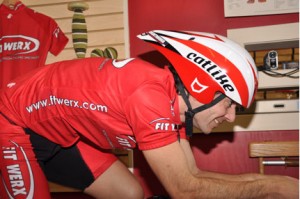Aero Helmets and Heat
Tri-Hard | www.tri-hard.com
Tri-Hard’s Scientific Study of the Month – Aero Helmets and Heat
March 2014 Citation: Effect of an Aerodynamic Helmet on Head Temperature, Core Temperature, and Cycling Power Compared With a Traditional Helmet. Journal of Strength and
Citation: Effect of an Aerodynamic Helmet on Head Temperature, Core Temperature, and Cycling Power Compared With a Traditional Helmet. Journal of Strength and
Conditioning Research 27(12): 3,402-3,411, 2013.
Insight from the Study:
The researches of this study examined the effects of wearing an aerodynamic
cycling helmet on head and core body temperature during a low intensity 30-
minute ride (50 percent of VO2 max) and during a 12-kilometer self-paced time
trial.
The study participants performed two batteries of testing, one wearing a nonventilated
aerodynamic-style helmet and a ventilated traditional-style helmet with
a 48-hour recovery period between tests.
The athletes were heat acclimated pre-testing and the tests were performed in a
39 degrees Celsius (102 degrees Fahrenheit) setting. Head and core body
temperature were taken through the trials.
The key finding was that head temperature does increase while wearing an
aerodynamic helmet (for both the low-intensity and time-trial style portions of
the testing), but that core temperature and heart rate during the tests were the
same for both helmet styles. Also, power output, for the durations looked at in
this study, was not limited by wearing an aerodynamic helmet in the heat.
Take-Home Message:
Very often we are asked about whether someone should wear an aero helmet or
standard helmet during a race. Given the very positive aerodynamic benefit of
an aero helmet, outside of very specific situations, we tend to suggest that you
wear one.
One key to note from this study, however, is that the participants’ heads did
become hotter in the aero helmet even in these relatively short bouts of riding.
What happens in a long triathlon? There is a big difference between testing that
totals less than an hour and racing a triathlon from two to 15 hours.
The fact is that aerodynamically an aero helmet will be faster over all distances.
However, if you feel hot, you are very likely to start slowing down as a result of
that feeling, and you are likely to start losing confidence. As a result, your net
speed is likely to fade despite the aero helmet offering time savings. The longer
the race, the more this is true.
So, for any race where you feel it is comfortable temperature-wise (this is a good
rule because of how your physiology and perception changes based on your
level of heat acclimation), wear an aero helmet. For example, a 75-degree race
in March for an athlete from Boston can be a major heat stress. But in the
summer, a 75-degree race may feel very comfortable and not be a heat stress.
Some good rules of thumb:
1. For sprint-distance triathlons, wear an aero helmet in all conditions.
2. For Olympic-distance triathlons, wear an aero helmet in all but the hottest
conditions.
3. For half-iron distance and iron-distance triathlons, wear an aero helmet when
the temperature feels comfortable. If it feels hot, skip the aero helmet.
